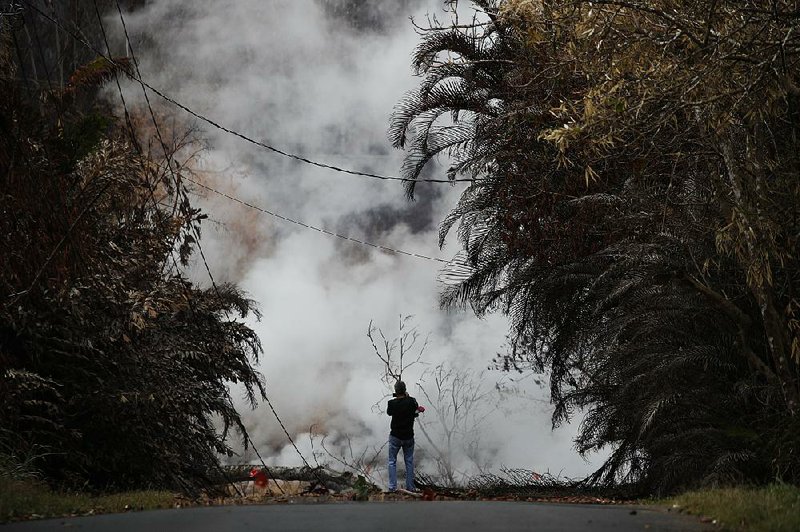PAHOA, Hawaii -- Lava creeping across roadways destroyed four homes and left dozens of others in the shadow of Hawaii's Kilauea volcano isolated Saturday, forcing more residents to plan for a possible evacuation.
Hawaii County Civil Defense said a fissure near the neighborhood of Lanipuna Gardens has been continuously erupting, releasing slow-moving lava. If that lava threatens a nearby highway, more people will be told to prepare for voluntary evacuation.
On Friday, fast-moving lava crossed a road and isolated about 40 homes in a rural subdivision, forcing at least four people to be evacuated by county and National Guard helicopters.
The wide lava flow was "very active" Saturday morning and advancing at rates of up to 300 yards per hour, scientists from the Hawaiian Volcano Observatory said.
Police, firefighters and National Guard troops were securing the area of the Big Island and stopping people from entering, Hawaii County Civil Defense reported. The homes were isolated in the area east of Lanipuna Gardens and Leilani Estates. Both neighborhoods had 40 structures, including 26 homes, devastated by lava over the past two weeks.
Three people still in that area Friday night were initially advised to shelter in place and await rescue by helicopter first thing Saturday. Since then, two of them got out on their own in the morning and one was evacuated by air, said Janet Snyder, spokesman for Hawaii County.
"They shouldn't be in that area. We told them they will be locked in," said County Managing Director Wil Okabe. "It's more serious now. They're putting their lives at risk."
He said he hopes people heed evacuation warnings.
County officials have been encouraging residents in other parts of the district to prepare for potential evacuations.
Edwin Montoya, who lives with his daughter on her farm near the site where lava crossed the road and cut off access, said he was at the property earlier in the day to get valuables.
"I think I'm lucky because we went there this morning and we got all the batteries out, and all the solar panels out, about $4,000 worth of equipment," he said. "They have to evacuate the people that are trapped up there right now in the same place that we were taking pictures this morning."
He said no one was on his property, but his neighbor had someone on his land.
"I know that the farm right next to my farm, he's got somebody there taking care of the premises. I know he's trapped," Montoya said.
Montoya said the fissure that poured lava across the road opened and grew quickly.
"It was just a little crack in the ground, with a little lava coming out," he said. "Now it's a big crater that opened up where the small little crack in the ground was."
Experts are uncertain about when the volcano will calm down.
The Big Island volcano released a small explosion at its summit late Friday, sending an ash cloud 10,000 feet into the sky. The U.S. Geological Survey's Hawaiian Volcano Observatory said eruptions that create even minor amounts of ashfall could occur at any time.
This follows the more explosive eruption Thursday, which emitted ash and rocks thousands of feet into the sky. No one was injured and there were no reports of damaged property.
Scientists said the eruption was the most powerful in recent days, though it probably lasted only a few minutes.
It came two weeks after the volcano began sending lava flows into neighborhoods 25 miles to the east of the summit.
A new lava vent -- the 22nd such fissure -- was reported Friday by county civil defense officials.
Several open fissure vents are still producing lava splatter and flow in evacuated areas. Gas is also pouring from the vents, cloaking homes and trees in smoke.
The fresher, hotter magma will allow faster lava flows that can potentially cover more area, said Janet Babb, a geologist with the Hawaiian Volcano Observatory.
More explosive eruptions from the summit are possible.
It's nearly impossible to determine when a volcano will stop erupting, "because the processes driving that fall below the surface and we can't see them," said volcanologist Janine Krippner of Concord University in West Virginia.
Information for this article was contributed by Jae Hong, Marco Garcia, Sophia Yan, Jennifer Kelleher, Audrey McAvoy, Becky Bohrer, Seth Borenstein and Alina Hartounian of The Associated Press.
A Section on 05/20/2018
